
Throughout history, humans have associated time with the recurring events that took place around them. These events included the rotation of day and night, as well as the changing of seasons. In present times, this method of measuring time may not always meet our precise needs. However, it is a system that humanity has grown accustomed to, and considerable effort is dedicated to connecting ancient time measurement techniques with modern, accurate methods.
As a result of this, humanity has made the management of time more intricate by implementing various calendars, time zones, daylight saving, and not to mention the fact that there has not been a clear understanding of a fundamental unit like the second. And now, even with the definition of a second, efforts are being made to reconcile all the previously devised complexities with it.
Each occurrence takes place at a specific point in time. To establish this point in time for others to perceive, it is necessary to establish a universally accepted point in time as the starting point for counting, determine the intervals at which counting will occur, and count the appropriate number of intervals. In essence, it is similar to locating a point on an axis, a plane, or in space. However, as mentioned previously, humanity has made this process unnecessarily complex.
In the contemporary world, numerous tasks are conveniently measured in seconds and fractions of a second, however, for an extensive period, individuals relied on days and years for timekeeping. A day, also known as a solar day, denotes the duration during which the cycle of day and night occurs, while a year, specifically a tropical year, signifies the duration during which the cycle of seasons takes place.
It is common knowledge that the alteration in the time of day is attributed to the Earth’s rotation around its axis in relation to the center of the Sun, and the variation in seasons is a result of the Earth’s axial tilt and its revolution around the Sun. The tropical year is roughly equivalent to 365 solar days. The challenge lies in its inability to be expressed as an integer number of solar days. Consequently, if no action is taken, the seasons will gradually shift within the year.
The problem of accurately measuring time is addressed by the Julian and Gregorian calendars, which add extra days to the year.
Methods of Time Measurement
To assign a numerical value to a specific moment in time, different time scales are utilized. The most commonly used scales include:
TAI
The fundamental unit of time measurement is the second. It is currently defined as the duration of 9,192,631,770 periods of radiation corresponding to the transition between two specific energy levels of a caesium-133 atom at rest, without any external interference, at a temperature of 0 K. This unit of time is known as the atomic second. The first atomic second occurred on January 1, 1958, at 0 hours, 0 minutes, and 0 seconds Universal Time (UT2).
UT Global Time
Universal Time (UT) is based on the Earth’s rotation in relation to the sidereal space. Due to the non-uniform rotation, the duration of a second may vary slightly. Universal Time has undergone multiple refinements, resulting in the existence of different versions including UT0, UT1, and UT2. Currently, UT1 is the most commonly utilized version.
UTC
Universal Coordinated Time (UTC) was implemented to synchronize the non-uniform UT1 second with the constant atomic second.
The basic idea behind it is that scientists continuously monitor the disparity between UT1 and UTC. This disparity must not exceed 0.9 atomic seconds. To ensure this, the concept of a leap second was introduced, which can be added or subtracted depending on the difference.
UTC time differs from TAI time by a whole number of seconds and a fractional number of seconds from UT1 time. All seconds in UTC time remain constant.
A UTC second is equivalent to an atomic second, but the total number of seconds in a day can vary, being either 86400, 86399, or 86401 seconds. This variation complicates precise calculations, leading to ongoing scientific discussions about the possibility of abolishing leap seconds.
The GPS time scale has an ongoing discrepancy of 19 seconds with the international atomic time TAI. In GPS time, the count starts at 00h 00 min 06.01.1980 and is measured in GPS weeks and seconds within the current week. The week number in GPS time is allocated 10 bits, allowing for a maximum of 1024 weeks to be encoded. Every 1024 weeks, the count resets. The week counter was reset to zero on August 21, 1999 and April 6, 2019.
Terrestrial Time (TT)
TT is a conceptual time measurement system. The length of a second in TT is identical to that of TAI. However, TT differs from TAI by an offset of 32.184 seconds. Unlike TAI, which has a small margin of error, TT is considered to be a theoretical time scale with no significant error.
Unix
The most commonly used method for handling time in information technology is Unix time. In essence, Unix time is a numerical value that represents the number of seconds that have passed since January 1, 1970, at 0 hours, 0 minutes, and 0 seconds UTC time. This value increases by 86,400 for every 24 hours that elapse. By knowing the value of this counter, it is possible to determine the corresponding date and time. However, there is a slight complication when it comes to representing leap seconds in Unix time. When a leap second occurs in UTC time, Unix time either repeats the last second of the day or skips it entirely. Therefore, it is not always possible to uniquely identify a specific moment in time based solely on the value of the seconds counter in Unix time.
An integer is employed to keep track of the seconds, and because various operating systems may exceed the maximum value for the counter, this can lead to an inaccurate time representation. If a signed 32-bit integer is utilized, the overflow will happen after 2^31 seconds or on January 19, 2038, at 03:14:07. It will then reset to December 13, 1901. However, if a 64-bit number is employed, the overflow will not occur even in the most distant future.
Java
In Java, there are also 86400 seconds in a full day. However, a specific moment in time is identified by an integer value representing the number of seconds. This is achieved by following the convention of evenly distributing a leap second among the last 1000 seconds of the day. In simpler terms, it is assumed that each of the final 1000 seconds of a day with a leap second is equivalent to 0.999 or 1.001 atomic seconds (UTC seconds). This helps account for any errors that may occur when measuring an RTC clock that utilizes a quartz oscillator.
Network Time Protocol (NTP) servers utilize Universal Coordinated Time (UTC) as their basis and can obtain time from various sources such as radio time signals, GPS signals, and other NTP servers. These servers also take into consideration the occurrence of leap seconds. However, the implementation of leap seconds can vary depending on the specific NTP server and operating system being used. In some cases, a server may provide advance notice of an upcoming leap second, leaving it up to the operating system to handle the adjustment (either by going back one second, freezing for a second, or ignoring it altogether). Alternatively, the server may automatically adjust for the leap second without notifying any connected devices.
Different operating systems have different approaches to handling leap seconds. For instance, Windows does not natively support leap seconds.
Time difference in various time scales
Various time scales have distinct initial points. Furthermore, due to the difference in seconds, the same moment in time will be interpreted differently across different scales.
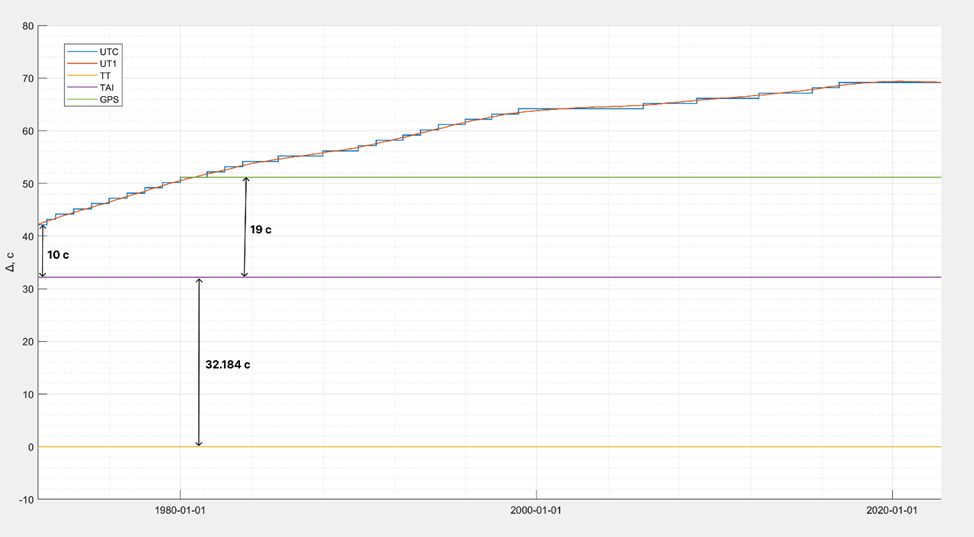
The diagram illustrates the primary time scales and their respective deviations, commencing from January 1, 1972 at 0 hours, 0 minutes, and 0 seconds UTC (the moment when UTC began to deviate by a whole number of seconds from UT1 and implemented leap seconds). The diagram reveals, for instance, that TAI time is 19 seconds ahead of GPS, while UTC time is progressively lagging behind TAI due to the introduction of leap seconds. The diagram also demonstrates the proximity of UTC time to UT1 time.
Time zones
The earth can be divided into 24 equal parts along the meridians, and a time difference from UTC time by one hour can be set for each part. This difference is known as the geographical time zone. For UTC time, it is +0, and generally, it can range from -11 to +12. However, this only takes into account the geographical position and not the administrative affiliation. To account for administrative affiliation, administrative time zones were introduced, which bring forth many interesting aspects.
In administrative time zones, the offset value does not have to be a whole hour and can fall outside the -11 to +12 range. This means that there are now time zones such as +14, +5:30, or even +5:45 around the world. There is a special time zone, known as the date change line, which does not pass through any state and has an offset value of -12.
Moreover, the offset with respect to UTC can vary not just when traveling from west to east or east to west, but also when traveling from north to south or south to north.
GMT and time zones
In the past, noon was considered to be the time when the sun was directly overhead, so 12 o’clock in the afternoon was different for each city. This arrangement worked for everyone initially, as they could simply adjust their clocks upon arrival in a new city and not worry about it. However, when steam locomotives were introduced and train schedules needed to be coordinated, it became a logistical nightmare. As a solution, all trains began running on London time, and eventually GMT time and time zones were established. GMT time allows for a specific moment in time to be universally defined, while time zones ensure that 12 hours of daylight and 6 hours of evening are consistent within a given area. Currently, GMT time is synonymous with UTC time.
Date Change Line
To account for the Earth’s spherical shape, there needs to be a way to establish the current location on Earth as well as the future location. This division between today and tomorrow is known as the Date Line. While it could have been placed along the Greenwich meridian, this would have been highly impractical as it would intersect numerous populated areas, resulting in inconvenient situations where one part experiences today while another experiences tomorrow. Therefore, it was determined that the Date Line should be situated along the least populated region of the Pacific Ocean.
Standard and Daylight Saving Time
Administrative time zones alone were not enough, so the concept of daylight saving time was introduced. The purpose of daylight saving time is to conserve energy consumption. Essentially, in the spring, the clock hands are moved one hour ahead of standard time, and in the winter, they are moved one hour back. The specific timing of this change varies among different countries, resulting in situations where some places are still observing daylight saving time while others have already ended it. This can often lead to disruptions in geographically dispersed teams.
Many scientists now argue that changing the clocks can cause stress on the human body, as it needs to readjust its internal clock.
There is a growing trend of countries abandoning daylight saving time.
If you thought that was insufficient, it is worth mentioning that various administrative time zones could be in effect across different regions at different points in time. To simplify the tasks of programmers dealing with such scenarios, the Time Zone Database was created, which is continuously updated and enhanced. It contains source code for handling time zones, as well as comprehensive descriptions of all known time zones (including when and which time zone was utilized in a specific area, and when daylight saving time was implemented or revoked). Many operating systems and databases utilize this database to manage dates and times. As definitions change over time, it is necessary to regularly update the time zone definitions within the operating system or database management system.
Leap year. Daylight Saving Time. Leap second
A leap year alters the total number of days in a calendar year.
Daylight Saving Time impacts the adjustment of local time in relation to Coordinated Universal Time (UTC), and also modifies the duration of a day when transitioning to and from Daylight Saving Time. During the occurrence of Daylight Saving Time, a day lasts 25 hours, while Daylight Saving Time itself lasts for 23 hours. Since UTC does not observe Daylight Saving Time, a UTC day always lasts for 24 hours.
A leap second modifies the total number of seconds in a year. Theoretically, a leap second can be either added or subtracted, and can potentially occur up to four times within a year.
Local time vs UTC
In certain situations, it is convenient to utilize local time, while in others UTC time is preferred.
For instance, let’s consider a work shift that begins at 10 and lasts for 8 hours based on local time. This means that if we assume the shift commenced at 10 PM according to local time, it should conclude at 6 AM based on local time, regardless of whether there was a switch between summer and winter time during the shift. In reality, the employee may work 7 or 9 actual hours, but it will be considered as 8 hours based on local time.
Let’s consider another scenario. A plane departs from the airport at 10 o’clock in the local time. The duration of the flight is 8 hours. It is not feasible to use the local time for calculations. If we add 8 hours to the local time, we will get 6 am in the local time. However, this can lead to incorrect results if the flight was conducted during the transition from winter to summer time or vice versa, even if we assume that the plane did not cross any time zones.
There are more complex situations where a plane departs from one time zone and arrives in another without any conversion for winter or summer time. To solve such a problem, we need to convert the local time to UTC time, perform all the necessary calculations, and then convert it back to the local time of the desired time zone to determine the local arrival time.
Final Thoughts
This article does not include any source code or program libraries, but rather focuses on the fundamental concepts necessary for writing programs that involve time manipulation.
However, I believe that the information provided in this article is sufficient for you to organize your understanding of time and learn something new. Working with time involves numerous fascinating facts and peculiarities, which unfortunately could not all be covered in this concise article. If you find the topic of time intriguing and desire further exploration, I am willing to provide a continuation.
If you happen to notice any inaccuracies in this article, please feel free to point them out in the comments. Your feedback is greatly appreciated.

All of our lives are intertwined with the concept of time, which is governed by the cyclic nature of day and night and the changing of seasons. In this lesson, we will explore various methods for accurately determining the time at any location across the globe. We will discover the relationship between measuring time by the solar day and the geographic meridian. Additionally, we will delve into the concept of the date line and its geographical placement. Lastly, we will delve into different calendar systems and the underlying principles upon which they are constructed.
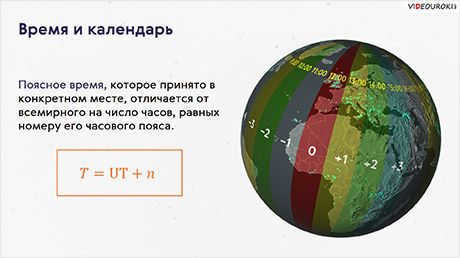
Unfortunately, it is currently not possible to view or share the video tutorial with your students
In order to gain access to this and other video tutorials included in the package, you will need to add it to your personal account.
Unlock amazing possibilities


Outline of the lesson “Time and Calendar”
Our entire existence is intertwined with time and governed by the cyclical nature of day and night, as well as the changing seasons. It is common knowledge that the Sun only shines on one hemisphere at a time, resulting in daytime on one side of the globe and nighttime on the other. As a result, there are always specific locations on Earth where it is precisely noon and the Sun is at its highest point, while at the same time, there are places where it is midnight and the Sun is at its lowest point.

The exact time when the center of the Sun reaches its highest point in the sky is referred to as exact noon. Conversely, the exact time when the center of the Sun reaches its lowest point is known as exact midnight. Additionally, the duration between two successive instances of the Sun reaching the same zenith at its center is known as an exact solar day.
The measurement of time by solar day is associated with the geographical meridian. The time measured at a specific meridian is referred to as its local time, and it remains the same for all points on that meridian. In this case, the further eastward the Earth’s meridian is, the earlier the day starts on it. Taking into consideration that our planet rotates around its axis by 15° every hour, the time difference between two points in one hour corresponds to the difference in longitudes by 15°. Therefore, the local time in two points will differ exactly as much as their geographic longitude, expressed in hours, differs:
T1 – T2 = λ1 – λ2.
As you learned in your geography class, the starting meridian, also known as the zero meridian, is the one that passes through the Greenwich Observatory near London. The local mean solar time at the Greenwich meridian is referred to as Universal Time or UT for short.
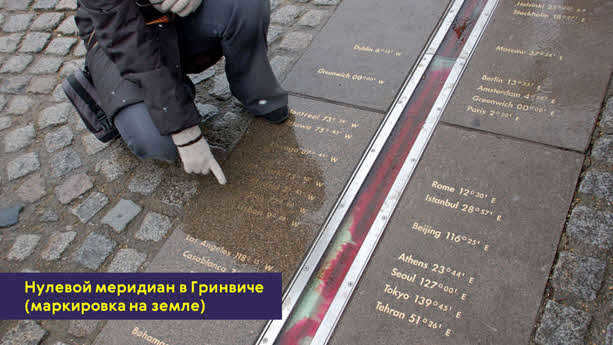
By knowing the Universal Time and the geographical longitude of any location, it is possible to easily calculate its local time:
T1 = UT + λ1.
This equation can also be used to determine the geographical longitude based on the local time and the world time, which can be calculated through astronomical observations.
However, if we were to use local time in our everyday lives, we would need to adjust the clock hands as we move between places located to the east or west of our current location.
For instance, let’s calculate the time difference between noon in St. Petersburg and Moscow, assuming their geographical longitudes are known in advance.
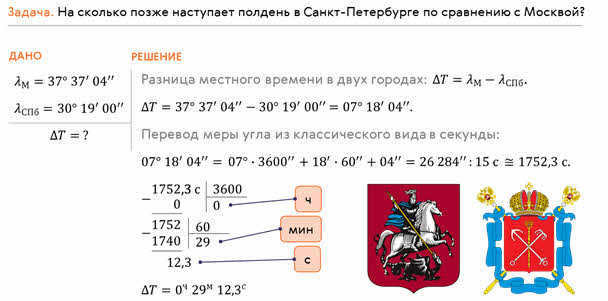
To put it differently, the time in St. Petersburg will be approximately 29 minutes and 12 seconds later than in Moscow.
The resulting inconvenience is so evident that nowadays nearly the entire global population utilizes the time zone system. It was proposed by Charles Dowd, an educator from the United States, in 1872 for implementation on American railways. In 1884, the International Meridian Conference took place in Washington, D.C., which led to the suggestion to adopt Greenwich time as the worldwide standard.
The global time system divides the entire planet into 24 time zones, with each zone covering a 15° longitude (equivalent to one hour). The time zone at the Greenwich meridian is designated as zero. Moving eastward from zero, subsequent zones are numbered from 1 to 23. Within each zone, all points share the same time at all times, while neighboring zones differ by exactly one hour.
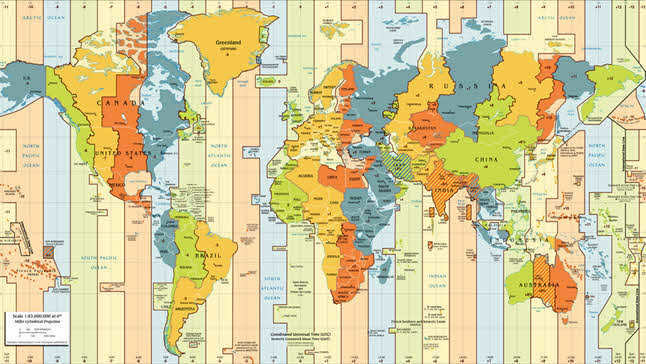
Therefore, the local time, which is observed in a specific location, varies from the international time by the number of hours corresponding to its time zone:
T = UT + n.
If we examine the time zone map, we can easily see that the boundaries of these zones align with meridians only in sparsely populated regions, such as seas and oceans. In other areas, the boundaries of the time zones are adjusted to state and administrative borders, mountain ranges, rivers, and other natural landmarks for convenience.
Additionally, there is an imaginary line that runs from pole to pole on the Earth’s surface, where local time on either side of the line differs by nearly a full day. This line is known as the date line. It roughly follows the meridian 180 o .
At present, atomic time is regarded as the most dependable and convenient form of timekeeping. Atomic time was established by the International Committee of Weights and Measures in 1964. Atomic clocks were universally adopted as the standard for time measurement, with an error rate of approximately one second every 50 thousand years. As a result, since January 1, 1972, countries around the world have been using atomic time as the basis for their timekeeping.
For the purpose of measuring long periods of time, during which a specific number of months, their sequence in the year, and the starting point for counting years are established, the concept of a calendar was introduced. A calendar is based on recurring astronomical events, such as the Earth’s rotation on its axis, the cycle of lunar phases, and the Earth’s revolution around the Sun. In every calendar system (of which there are over 200), three fundamental units of time measurement are utilized: the average solar day, the synodic month, and the tropical (or solar) year.
It is worth noting that a synodic month refers to the time duration between two consecutive identical phases of the Moon. It is approximately 29.5 days in length.
A tropical year refers to the period of time between two consecutive passages of the Sun’s center through the vernal equinox. Since January 1, 2000, its average length has been 365 d 05 h 48 min 45.19 s.
It is worth noting that the synodic month and tropical year do not consist of a whole number of average solar days. As a result, various cultures have attempted to reconcile the day, month, and year in their own unique ways. This has led to the development of different calendar systems throughout history. However, all calendars can be broadly categorized into three types: lunar, lunar-solar, and solar.
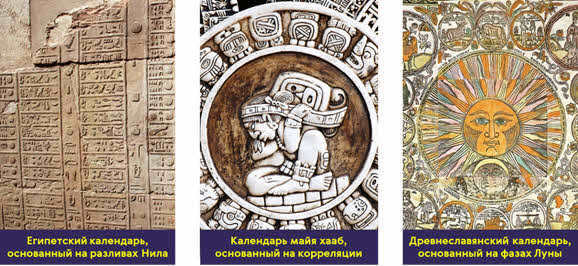
In the lunar calendar, the year is split into 12 lunar months, with alternating durations of 30 or 29 days. As a result, the lunar calendar is shorter than the solar year by approximately ten days. This type of calendar has gained popularity in the modern Islamic world.
Lunar-solar calendars are the most intricate. They are based on the principle that 19 solar years are equivalent to 235 lunar months. Consequently, a year can consist of either 12 or 13 months. Currently, this system is maintained in the Jewish calendar.
The solar calendar is founded on the length of the tropical year. One of the earliest solar calendars can be traced back to the ancient Egyptian calendar, which was established around 5 millennia BC. This calendar divided the year into 12 months, each with 30 days, and included an additional 5 celebratory days at the end of the year.
The calendar that came before the modern one was created on January 1, 45 BC in ancient Rome under the direction of Julius Caesar (hence its name – Julian). This was known as the Julian calendar.)
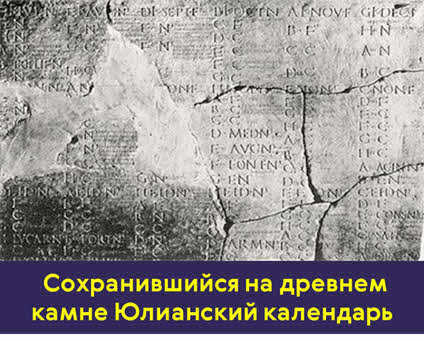
The calendar known as the Julian calendar consisted of 365.25 days, which was believed to be the length of the tropical year at that time. To make it more convenient, it divided each year into three 365-day periods. Additionally, a leap year was designated every four years, in which an extra day was added to the month of February. This extra day was known as a leap day.
However, despite its practicality, the Julian calendar was not perfect. It deviated from the actual length of the tropical year by 11 minutes and 14 seconds. While this may seem insignificant, it became apparent by the mid-16th century that the vernal equinox, which is associated with important religious holidays, was shifting by 10 days.
To rectify this accumulated error and prevent future shifts, Pope Gregory XIII introduced a calendar reform in 1582. This reform involved advancing the count of days by 10 days.
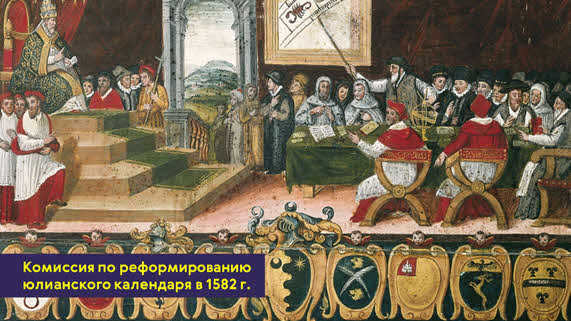
Simultaneously, in order to align the average calendar year more accurately with the solar year, Gregory XIII modified the rules for leap years. The leap year still occurred every four years, but an exception was made for years divisible by one hundred. These years were leap years only if they were also divisible by 400. For instance, 1700, 1800, and 1900 were ordinary years, while 1600 and 2000 were leap years.
The revised calendar became known as the Gregorian calendar or the new style calendar.
Russia adopted the new style calendar in 1918, by which time a discrepancy of 13 days had accumulated between it and the old style.
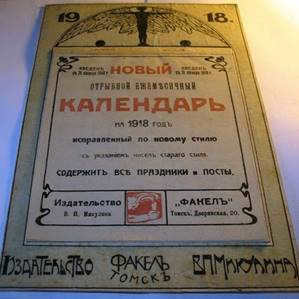
Nevertheless, the ancient calendar remains vivid in the recollections of numerous individuals. It is owing to this calendar that numerous countries in the former Soviet Union commemorate the “old New Year” on the night of January 13-14.
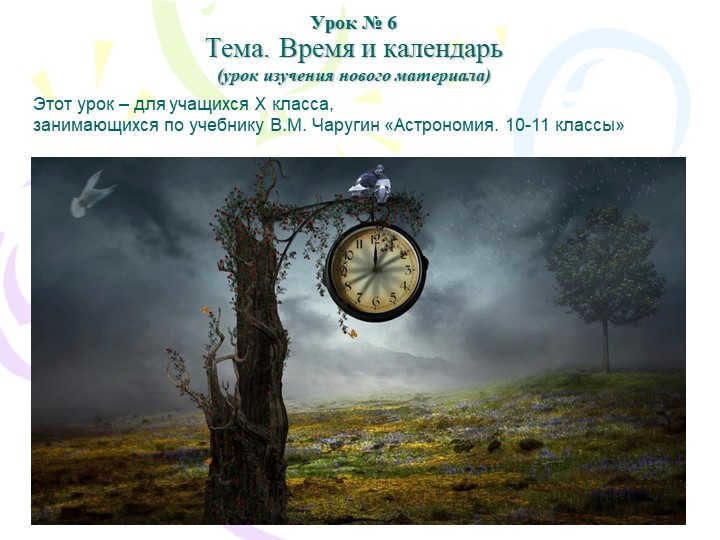
Currently, 58,742 educational institutions are eligible for additional cumulative discounts ranging from 2% to 25%. To determine the discount available to all staff members of your educational institution, please sign in to your personal Infoworks account.


Professional course for retraining
Designing and maintaining requirements and technical specifications for the development and modernization of small and medium-scale systems and subsystems with varying complexity
We can apply a discount from your educational institution to this discount (depending on the number of colleagues who have taken Infowork courses).
Currently, there are additional cumulative discounts (ranging from 2% to 25%) available for 58,742 educational institutions. To find out what discount is available for all employees of your educational institution, please log in to your personal Infoworks account.


Course for Professional Advancement
Preventing Teachers from Professional Distortion
We can apply the discount offered by your educational institution to this discount (the amount depends on the number of your colleagues who have completed the Infowork course).
Currently, 58,742 educational institutions are eligible for additional discounts (ranging from 2% to 25%). To find out the discount available to all employees of your educational institution, please log in to your personal Infoworks account.


Particulars of working in the field of speech therapy with young kids
Overview of the presentation through individual slides:

Slide 1 – Lesson Number 6
Topic: Time and Calendar
(Lesson on learning new material)
This lesson is designed for X grade students who are studying the textbook “Astronomy. Grades 10-11” by V.M. Charugin.
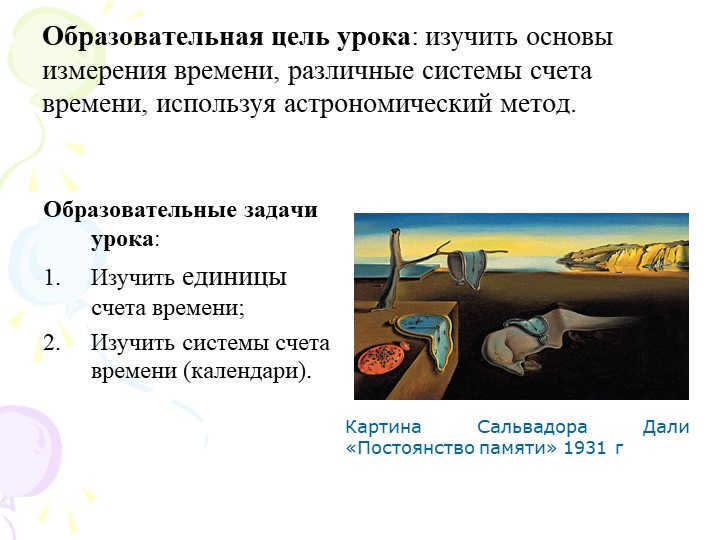
Slide 2: The main goal of this lesson is to gain knowledge about the fundamentals of time measurement and various systems used for counting time, with a focus on the astronomical approach.
The educational objectives for this lesson are as follows:
– To explore the units used for measuring time.
– To examine different time counting systems, including calendars.
– To analyze Salvador Dali’s artwork titled “The Permanence of Memory” from 1931.
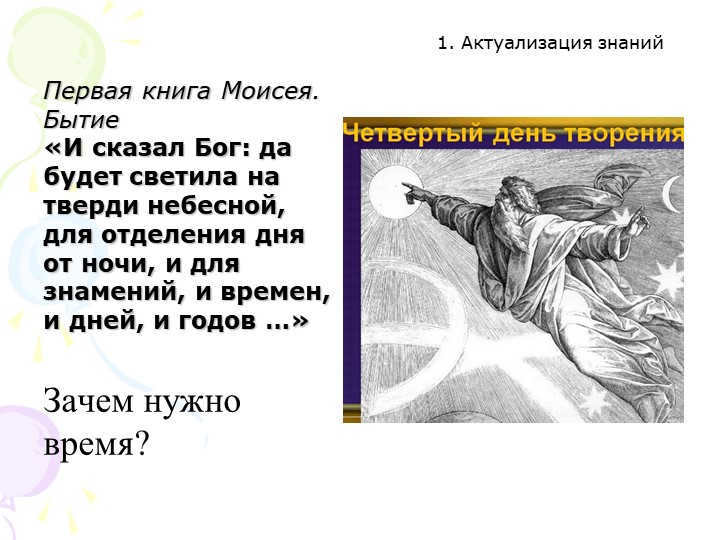
Slide 3 of The first book of Moses. Genesis
“And God commanded, ‘Let there be luminaries in the sky, to separate day from night, and to serve as signs, seasons, days, and years…’
Why is time necessary?
1- Knowledge actualization
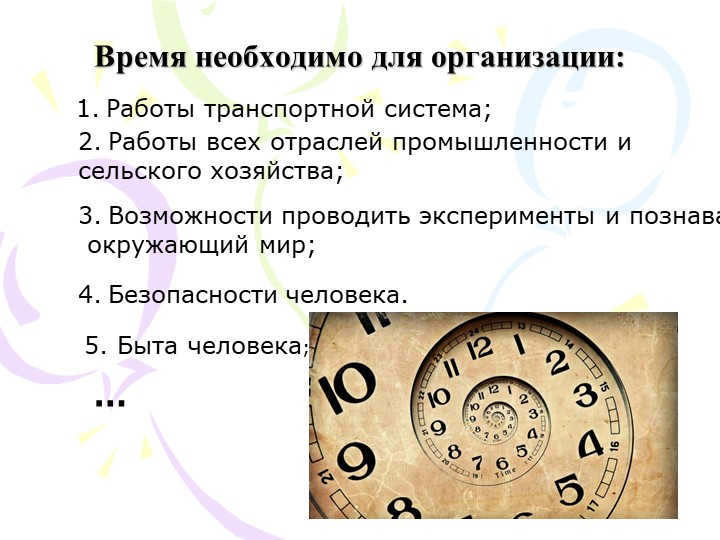
Time is essential for the coordination of various aspects:
1. The functioning of the transportation system;
2. The operations of all sectors of industry and
agriculture;
3. The ability to conduct experiments and explore
the world around us;
5. The creation and development of the human race;
4. Ensuring human safety.
…
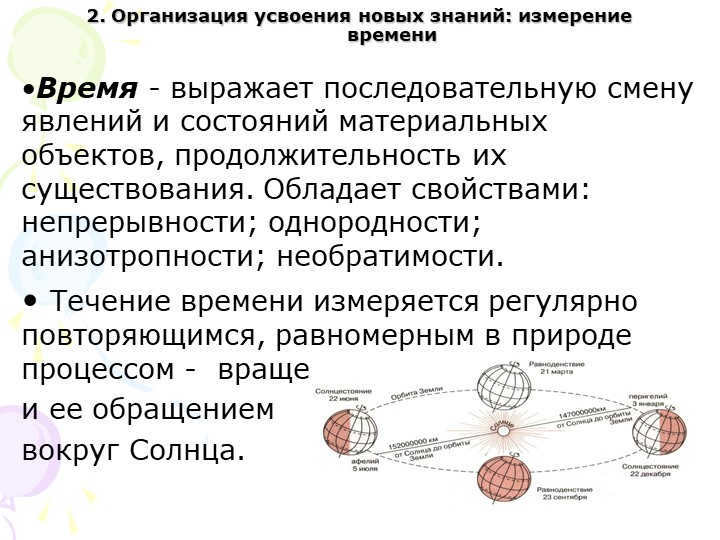
Slide 5. Organization of acquiring fresh information: time measurement
Time – denotes the sequential alteration of events and conditions of physical entities, the length of their existence. It possesses the subsequent characteristics: continuity; uniformity; directionality; irreversible nature.
The progression of time is assessed by a consistently repeating, consistent phenomenon in the natural world – the Earth’s rotation
and its orbit
around the sun.
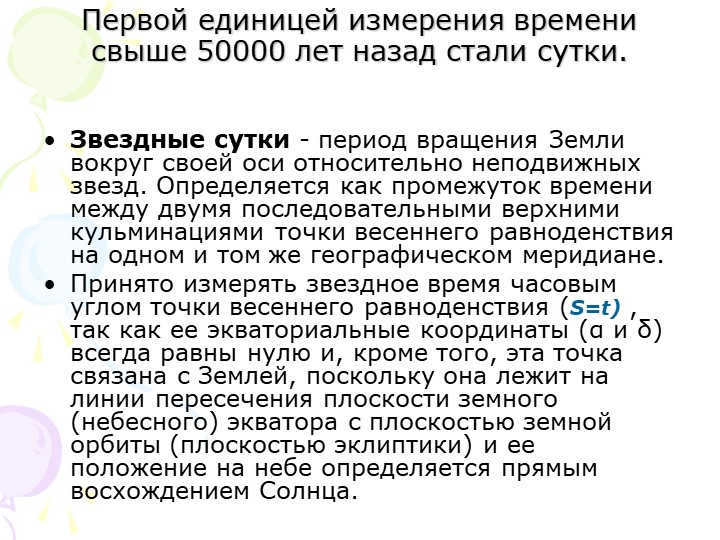
6 slide The initial form of measuring time, which emerged more than 50,000 years ago, was based on the concept of a day.
A sidereal day is the time it takes for the Earth to complete one full rotation on its axis in relation to the fixed stars. This is measured as the duration between two consecutive upper culminations of the vernal equinox point along the same geographic meridian.
Sidereal time is commonly measured using the hour angle of the vernal equinox point (S=t). This is because the equatorial coordinates (α and δ) of this point are always zero, and it is positioned on the line where the Earth’s celestial equator intersects with the plane of the Earth’s orbit (ecliptic plane). The position of the vernal equinox point in the sky is determined by the direct ascent of the Sun.
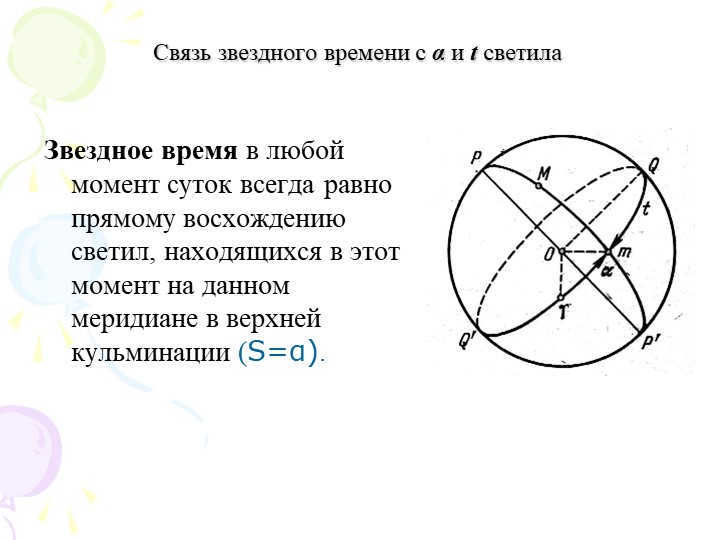
Slide 7: The connection between sidereal time and the α and t of the luminary
The sidereal time during any point in the day is always equivalent to the right ascension of the luminaries that are currently on the given meridian at their highest point (S=α).
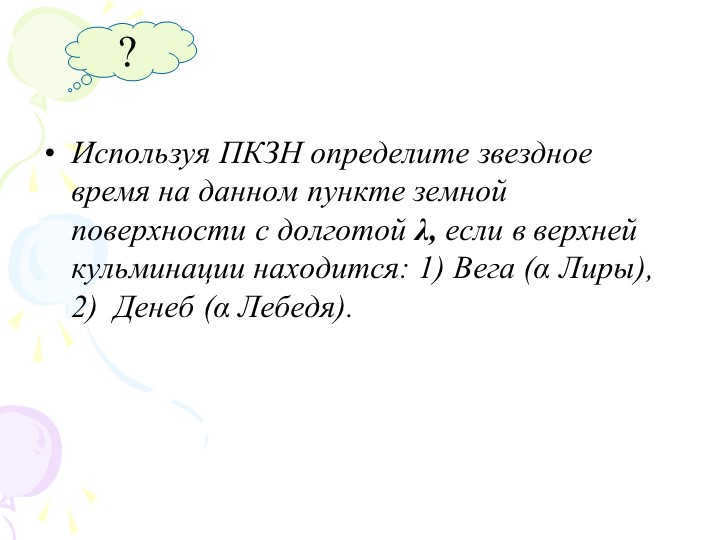
8 slide Use the PCZN to calculate the sidereal time at a specific location on Earth’s surface with a longitude of λ, when Vega (α Lyra) is in its upper culmination, and when Deneb (α Swan) is in its upper culmination.
?
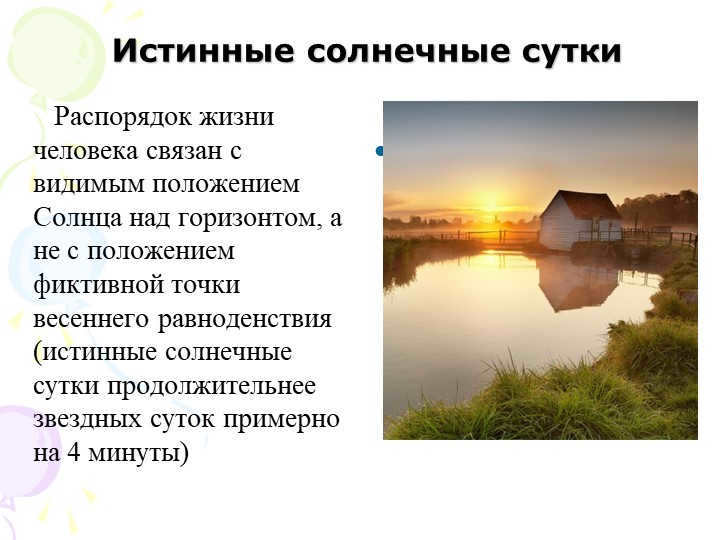
Slide 9 True solar day
The arrangement of human existence is connected to the observable location of the Sun above the horizon, rather than the location of the imaginary point of the vernal equinox (a true solar day is roughly 4 minutes longer than a sidereal day).
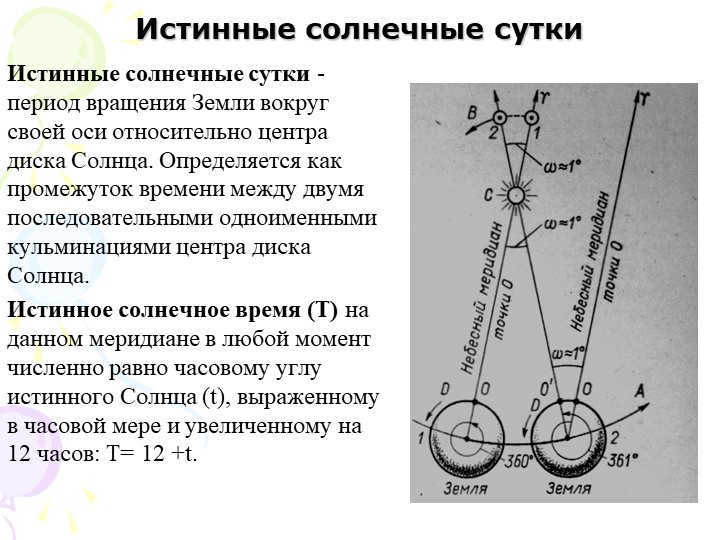

Slide 10 on the True Solar Day
The true solar day refers to the time it takes for the Earth to complete one full rotation around its axis in relation to the center of the Sun’s disk. It is measured as the duration between two consecutive instances when the center of the Sun’s disk reaches its highest point in the sky, also known as culminations.
In order to determine the true solar time (T) at a specific meridian at any given moment, it is necessary to calculate the hour angle of the true Sun (t) and add 12 hours: T = 12 + t.
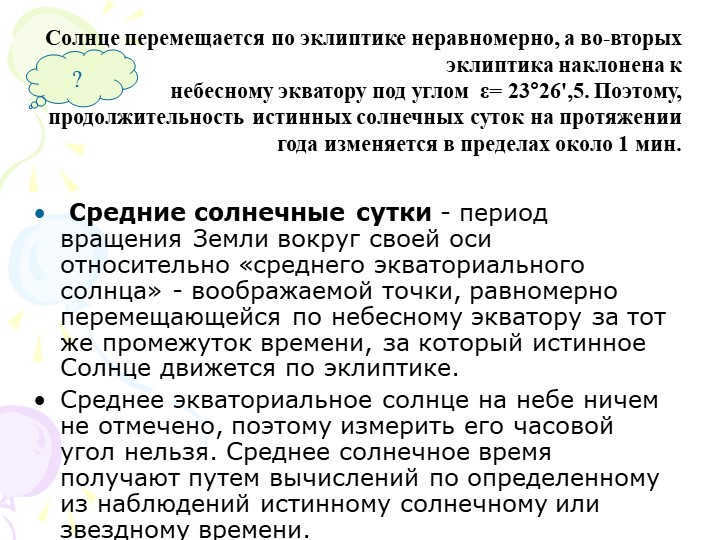
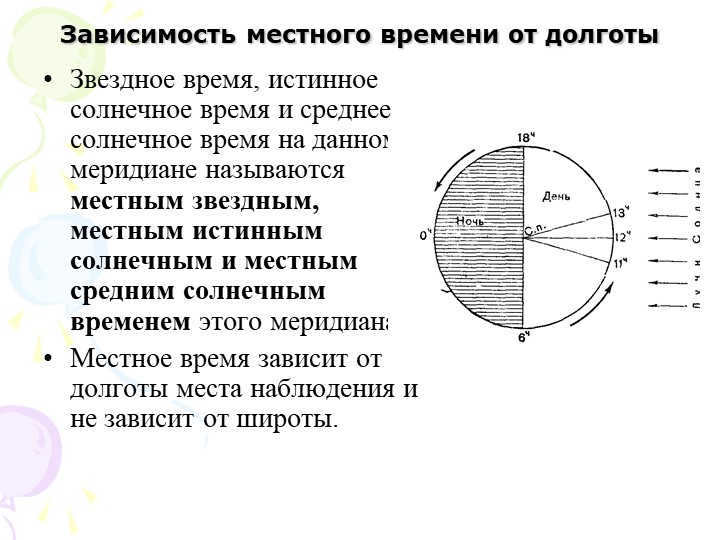
The local time at a particular meridian is determined by the longitude of the place of observation. The local sidereal time, local true solar time, and local mean solar time are all influenced by the longitude of the meridian. This means that the time at a specific location is unique to that longitude and is not affected by the latitude of the area.
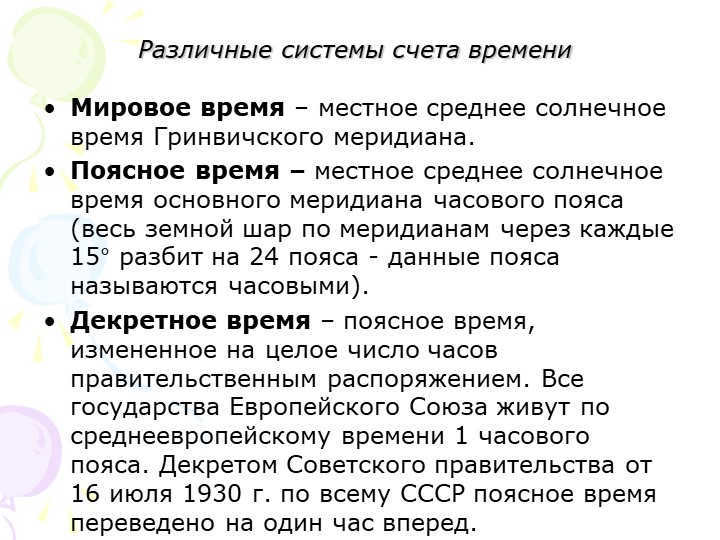
13 slide Different systems of counting time
World time is the local mean solar time of the Greenwich meridian.
Zone time – local mean solar time of the main meridian of the time zone (the entire globe is divided into 24 zones every 15° along the meridians – these zones are called time zones).
Ordinary time is the zone time adjusted by a whole number of hours by a government decree. All countries in the European Union adhere to the average European time of one time zone. By the decree of the Soviet government on July 16, 1930, the zone time across the USSR was moved one hour ahead.
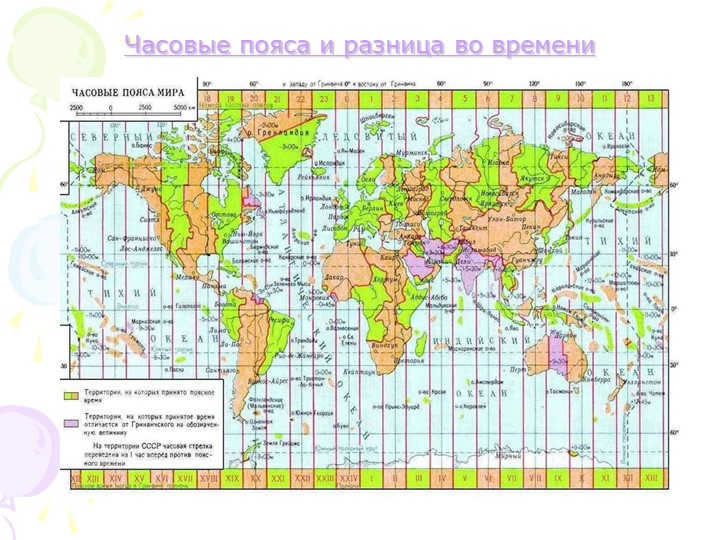
Slide 15: Changing the date line
The date line, also known as the demarcation line, is a meridian that spans across the Pacific Ocean, encompassing a 180° arc.
For instance, areas to the west of the date line are considered to be on one calendar date, while areas to the east are considered to be on the previous date. This means that noon in Chukotka and Alaska, separated by the Bering Strait, occurs at almost the same time, but the calendar date in Chukotka is one day ahead of the date in Alaska.
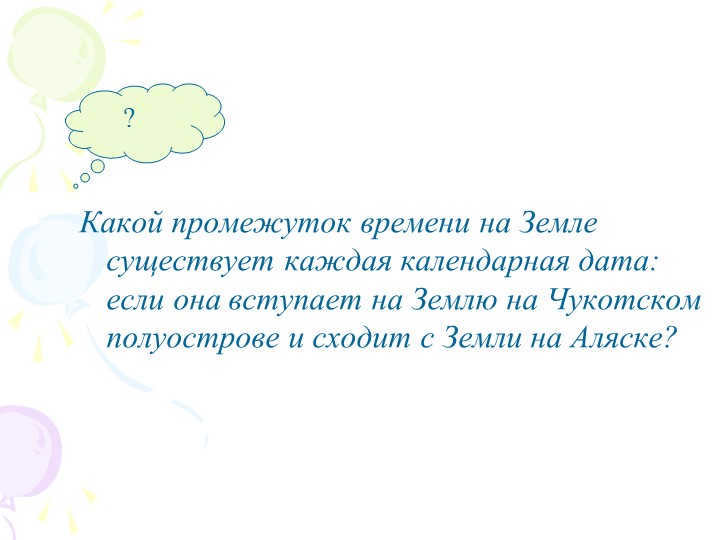

What is the duration for which each calendar date is present on Earth: when it starts on the Chukchi Peninsula and ends in Alaska?
?

Slide 18: The sequence of date alteration when crossing a demarcation line:
1. When crossing the demarcation line in the direction from west to east, the date needs to be repeated twice (after the 21st day, the 21st is counted again);
2. When crossing the demarcation line in the direction from east to west, the date needs to be incremented by two numbers simultaneously (after the 21st number, it is immediately counted as 23).
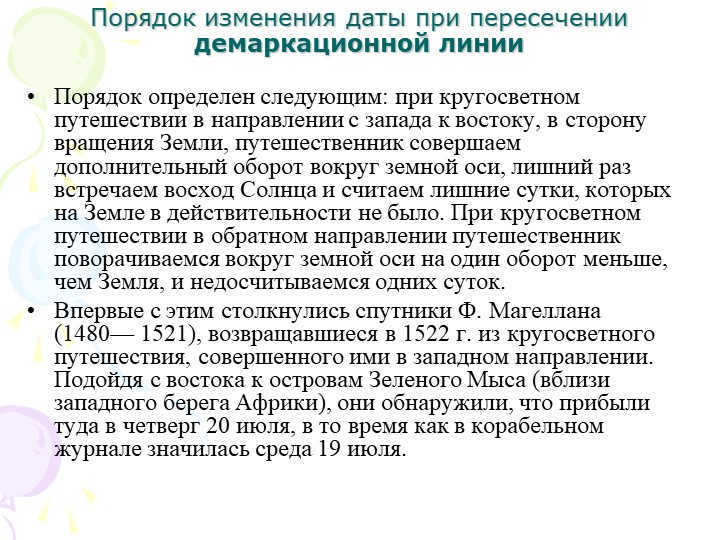
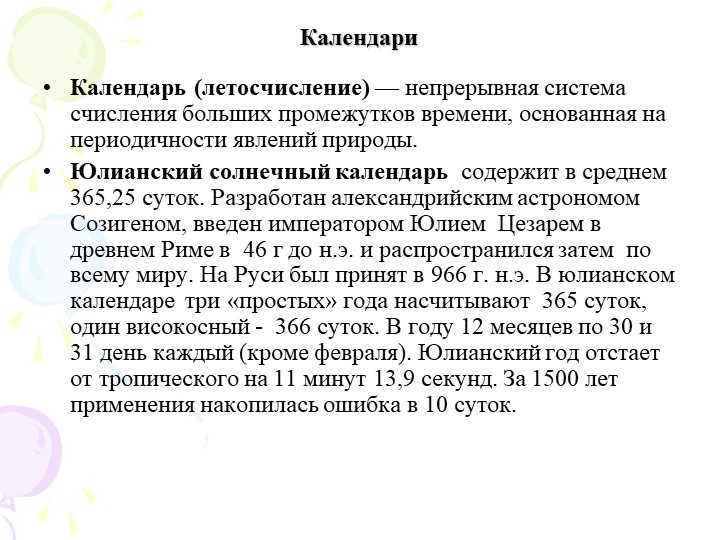
20 slide Calendars
Calendars are a system of numbering large intervals of time based on the periodicity of natural phenomena. The Julian solar calendar, which contains an average of 365.25 days, was developed by the Alexandrian astronomer Sozigen. It was introduced by Emperor Julius Caesar in ancient Rome in 46 BC and later adopted worldwide. In Russia, it was adopted in 966 AD. In the Julian calendar, there are three “simple” years with 365 days and one leap year with 366 days. The calendar consists of 12 months, with each month having 30 or 31 days (except February). However, the Julian year falls behind the tropical year by 11 minutes and 13.9 seconds. This discrepancy has accumulated to an error of 10 days over the course of 1500 years of use.
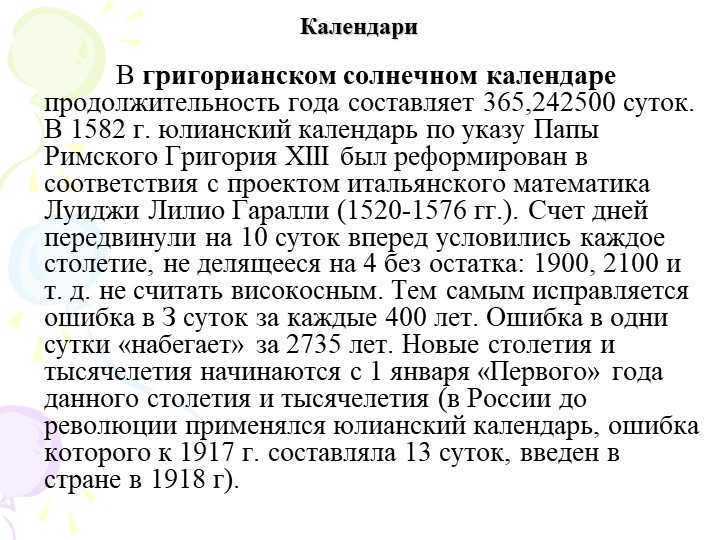
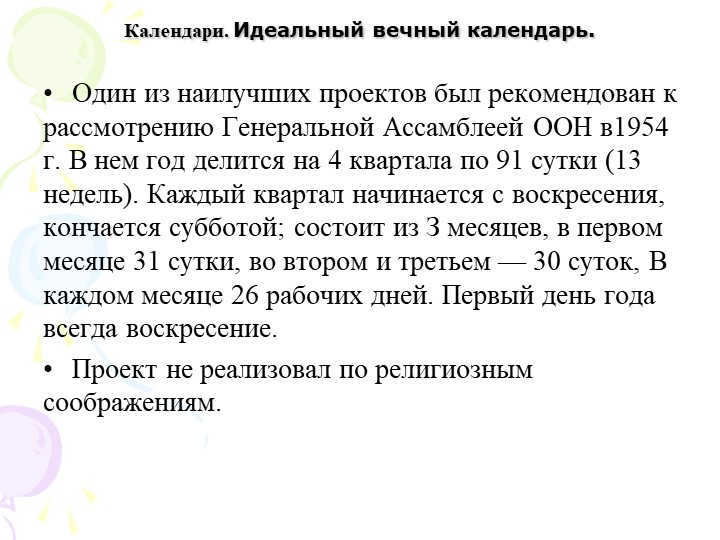
22 slide Calendars. A perfect perpetual calendar.
One of the top proposals that was suggested for review by the UN General Assembly in 1954. This calendar divides the year into 4 quarters, each consisting of 91 days (13 weeks). Every quarter starts on Sunday and ends on Saturday. Within each quarter, there are Z months, with the first month having 31 days and the second and third months having 30 days. Each month has 26 working days. The first day of the year always falls on a Sunday.
Unfortunately, the project did not come to fruition due to religious reasons.
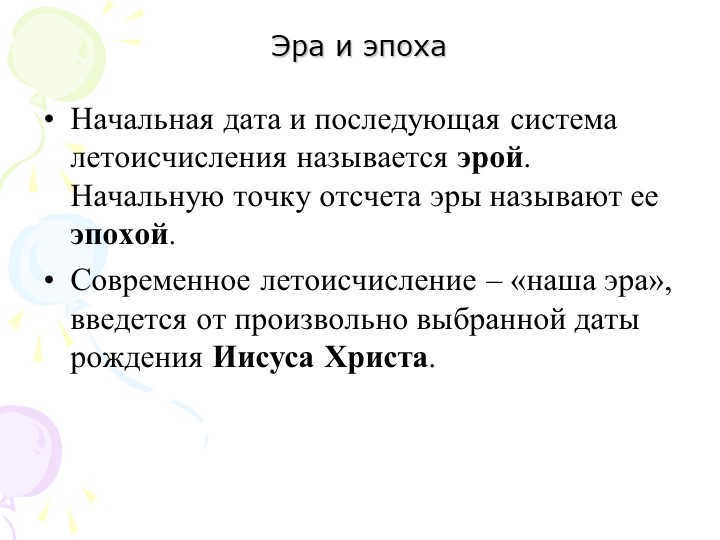
Slide 23: Era and epoch
The initiation date and following arrangement of chronology is known as an era. The beginning point of an era is referred to as its epoch.
Contemporary chronology, “our era,” is established from the arbitrarily selected date of the birth of Jesus Christ.
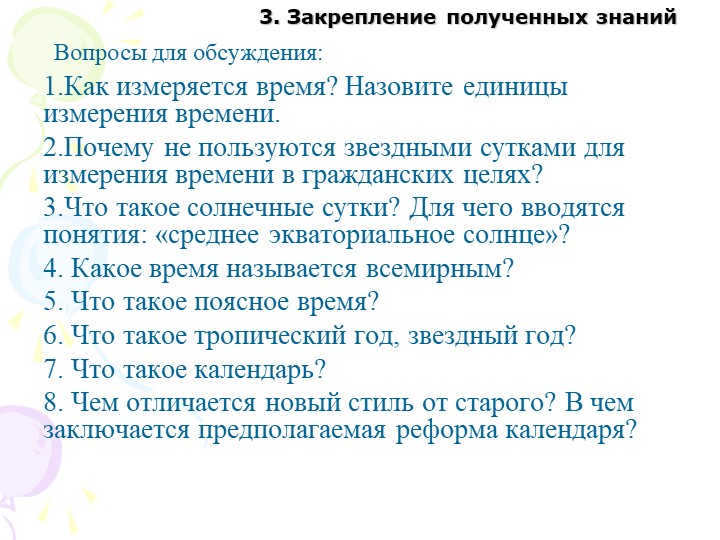
Slide 24: Consolidation of the knowledge gained
How is time measured? What are the units of time measurement?
Why aren’t sidereal days used to measure time for civilian purposes?
What is a solar day? What is the purpose of introducing the concept of “mean equatorial sun”?
What is universal time?
What is zone time?
What are tropical year and sidereal year?
What is a calendar?
What is the difference between the new style and the old style? What is the proposed calendar reform?
Discussion Questions:
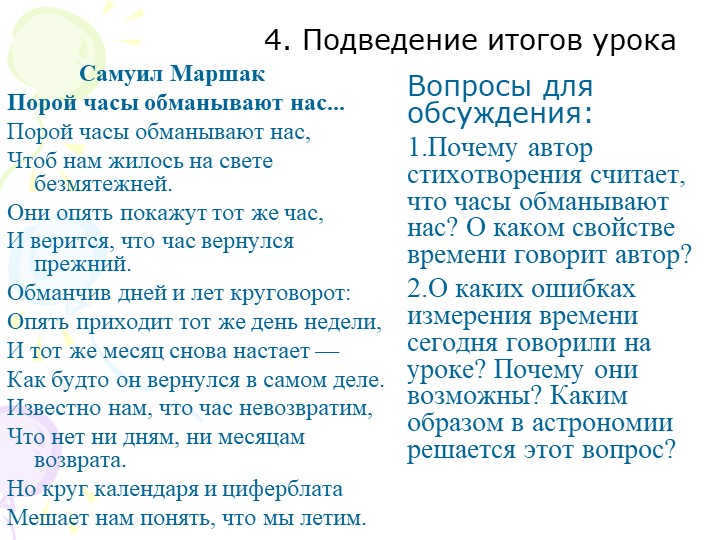
25 slide 4. Summarizing the lesson
by Samuel Marshak
At times, the clock plays tricks on us.
Occasionally, clocks trick us,
Allowing us to live in a more peaceful world.
They display the same hour again,
And we can believe that time has returned.
The days and the years are deceptive:
The same day of the week repeats,
And the same month comes around
As if it has returned.
We understand that time is irreversible,
That days and months cannot be brought back.
But the cycle of the calendar and the clock face
Prevents us from realizing that we are moving forward.
Discussion Questions:
Why does the poet believe that clocks deceive us? What aspect of time is the poet referring to?
What errors in measuring time were discussed in class today? Why are these errors possible? How does astronomy address this issue?
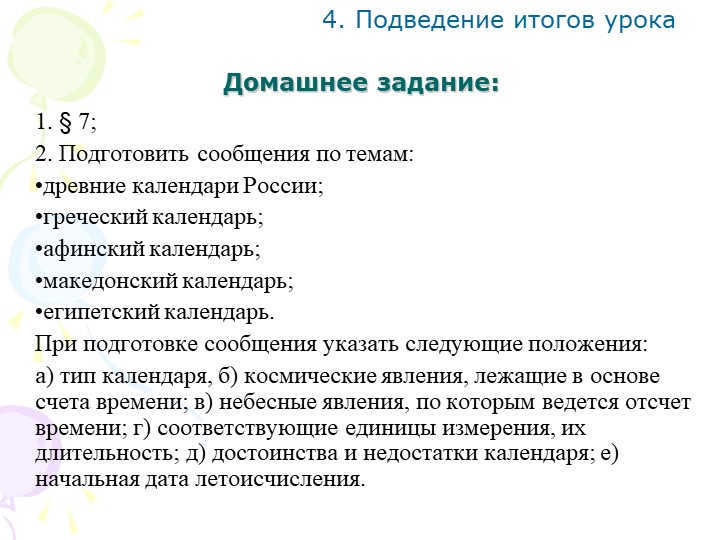
For homework assignment 26, you are required to prepare reports on the following topics:
1) Ancient calendars of Russia
2) Greek calendar
3) Athenian calendar
4) Macedonian calendar
5) Egyptian calendar
In your report, please include the following information:
(a) Type of calendar
(b) Cosmic phenomena used to measure time
(c) Celestial phenomena used to measure time
(d) Units of measurement and their duration
(e) Advantages and disadvantages of the calendar
(f) Initial date of the chronology
After completing the reports, we will summarize the lesson together.
Summary of the document:
This document provides a brief overview of the lesson designed for class X students who are studying the textbook “Astronomy. 10-11 grades” by V.M. Charugin. The lesson aims to teach students about time measurement and the different systems used to count time, with a focus on the astronomical method. The teacher-pupil interaction during the lesson is facilitated through the use of problem questions and various sources of information, as well as the integration of in-class and out-of-class cognitive activities.


The entire duration of our existence is intertwined with the concept of time and is regulated by the recurring transition between day and night, as well as the changing seasons. During this instructional session, you and I will acquire knowledge on various techniques that enable us to determine the precise time for any given location across the globe. We will delve into the interconnectedness between time measurement via solar days and the geographical meridian. Additionally, we will explore the concept of the international date line and its geographical placement. Furthermore, we will familiarize ourselves with different calendar systems and understand the foundational principles on which they are built.

At the moment, it is not possible for you to view or distribute the instructional video with your students
In order to gain access to this and other video lessons included in the package, you will need to include it in your personal account.
Unlock amazing possibilities


Lesson plan “Time and the Calendar”
Our lives are intricately connected to time and regulated by the cyclical patterns of day and night as well as the changing seasons. As you may be aware, the Sun only illuminates half of the earth at any given time, resulting in daytime on one hemisphere and nighttime on the other. This means that there are always specific locations on our planet where it is precisely noon and the Sun is at its highest point, while simultaneously there are places experiencing midnight when the Sun is at its lowest point.

The point in time when the center of the Sun reaches its highest point in the sky is referred to as true noon, while the point in time when the center of the Sun reaches its lowest point is referred to as true midnight. The duration between two consecutive occurrences of the same type of culmination at the center of the Sun is known as a true solar day.
It appears that they can be utilized to precisely count time. However, due to the elliptical orbit of the Earth, the length of the solar day periodically fluctuates. Consequently, when the Earth is closest to the Sun, it revolves at approximately 30.3 km/s. And after six months, the Earth is at its furthest point from the Sun, where its velocity decreases by 1 km/s. This uneven movement of the Earth in its orbit results in an irregular apparent movement of the Sun on the celestial sphere. In simple terms, at different times of the year, the Sun “travels” across the sky at different speeds. Hence, the duration of the true solar day is constantly changing and it is impractical to use it as a unit of time measurement. Subsequently, in everyday life, not the true solar day is employed, but rather the average solar day. Its duration is assumed to be constant and equal to 24 hours. Each hour of mean solar time is then subdivided into 60 minutes, and each minute is divided into 60 seconds.
The measurement of time by solar day is connected to a geographic meridian. The time measured at a specific meridian is known as its local time and it applies to all points on that meridian. Additionally, the further east the meridian, the earlier the day starts. Taking into consideration that our planet rotates 15° every hour, the time difference between two points corresponds to the difference in longitudes, expressed in hours. Therefore, the local time in two points will differ by the same amount as their geographic longitude difference:
T1 – T2 = λ1 – λ2.
As you learned in your geography class, the starting meridian, also known as the zero meridian, runs through the Greenwich Observatory near London. The local average solar time at the Greenwich meridian is referred to as Universal Time – abbreviated as UT.

By knowing the Coordinated Universal Time (UTC) and the longitude of any point, it is possible to easily calculate the local time:
T1 = UTC + λ1.
This equation also allows for the determination of the longitude based on the UTC and local time, which can be obtained through astronomical observations.
However, if we were to rely on local time in our everyday lives, we would have to constantly adjust the clock hands when traveling east or west from our current location.
For instance, let’s calculate the time difference between noon in St. Petersburg and Moscow, given their known longitudes.

To put it differently, St. Petersburg will experience a delay of approximately 29 minutes and 12 seconds compared to Moscow.
The resultant inconvenience is evident, which is why the majority of the global population now adopts the time zone system. This system was initially suggested by Charles Dowd, an American educator, in 1872 for implementation on American railroads. Subsequently, in 1884, the International Meridian Conference was held in Washington, where it was recommended that Greenwich time be adopted as the universal time.
Based on this system, the whole world is divided into 24 time zones, each of them covering a longitude of 15° (or one hour). The time zone at the Greenwich meridian is considered as zero. The remaining zones towards the east are numbered from 1 to 23. Within a single zone, the time remains constant at all points within that zone, while in adjacent zones, it differs by precisely one hour.

Therefore, the time zone, which is observed in a specific location, varies from the global time by the number of hours equal to its time zone:
T = UT + n.
By examining the time zone map, it becomes apparent that the boundaries of these zones coincide with meridians only in sparsely populated areas, such as seas and oceans. In more populated regions, the borders are established along state and administrative borders, mountain ranges, rivers, and other natural boundaries for convenience.
Moreover, there is an imaginary line that stretches from pole to pole on the Earth’s surface, where local time differs by almost a day on each side. This line is referred to as the date line and approximately follows the 180th meridian.
Currently, atomic time is regarded as the most dependable and convenient form of timekeeping. Atomic time, which was first established by the International Committee of Weights and Measures in 1964, has become the universally accepted standard for timekeeping. Atomic clocks, which have an error rate of approximately one second in 50 thousand years, have been used to measure time since January 1, 1972.
For the purpose of measuring extended periods of time, the calendar was established, which takes into account the duration of months, their order within the year, and the starting point for counting years. This system is built upon recurring astronomical events such as the Earth’s rotation on its axis, the cycle of lunar phases, and the Earth’s orbit around the Sun. In every calendar system (of which there are over 200), three fundamental units of time are utilized: the average solar day, the synodic month, and the tropical (or solar) year.
It is important to note that a synodic month refers to the time span between two consecutive identical phases of the Moon, which is roughly 29.5 days.
A tropical year is the period of time between two consecutive occurrences of the Sun’s center passing through the vernal equinox point. Its average length since January 1, 2000 is 365 days 5 hours 48 minutes 45.19 seconds.
It is evident that the synodic month and the tropical year do not consist of a whole number of average solar days. Because of this discrepancy, various nations attempted to reconcile the day, month, and year in their own unique ways. Consequently, different peoples throughout history devised their own calendar systems. However, all calendars can be categorized into three main types: lunar, lunar-solar, and solar.

In the lunar calendar, the year is divided into 12 lunar months, which consist of either 30 or 29 days. Consequently, the lunar calendar is approximately ten days shorter than the solar year. This type of calendar is widely used in the modern Islamic world.
Lunar-solar calendars are the most intricate. They are based on the ratio that 19 solar years are equivalent to 235 lunar months. As a result, the year can consist of 12 or 13 months. This system has been preserved in the Jewish calendar to this day.
The solar calendar is based on the duration of the tropical year. One of the earliest solar calendars is believed to be the ancient Egyptian calendar, which was developed around 5,000 years ago. It divided the year into 12 months, each consisting of 30 days, with an additional 5 festival days at the end of the year.
The Julian calendar, named after Julius Caesar, was developed on January 1, 45 BC in ancient Rome and served as the immediate predecessor to the modern calendar.

The calendar that was used before the Gregorian calendar was called the Julian calendar. It consisted of 365.25 days, which was the length of the tropical year at that time. To make it more convenient, it divided the year into three 365-day years. Additionally, every four years, an extra day was added in February, creating what was known as a leap year.
However, the Julian calendar was not perfect. There was a slight difference of 11 minutes and 14 seconds between the duration of the calendar year and the tropical year. This may not seem like much, but by the middle of the 16th century, it became apparent that the day of the vernal equinox, which is important for church holidays, was shifting by 10 days.
To rectify this accumulated error and prevent future displacements, Pope Gregory XIII implemented a calendar reform in 1582. This reform involved moving the count of days forward by 10 days.

Simultaneously, Gregory XIII modified the rule governing leap years in order to align the average calendar year more closely with the solar year. The leap year still occurred every four years, but an exception was made for years that were multiples of one hundred. These years were deemed leap years only if they were also divisible by 400. As a result, 1700, 1800, and 1900 were regular years, while 1600 and 2000 were leap years.
The revised calendar came to be known as the Gregorian calendar or the new style calendar.
In Russia, the new style calendar was not adopted until 1918. By that time, a discrepancy of 13 days had accumulated between the new style and the old style.

Nevertheless, the ancient calendar still remains ingrained in the recollections of numerous individuals. It is due to this calendar that in several countries of the former Soviet Union, the “old New Year” is commemorated on the night of January 13 to 14.
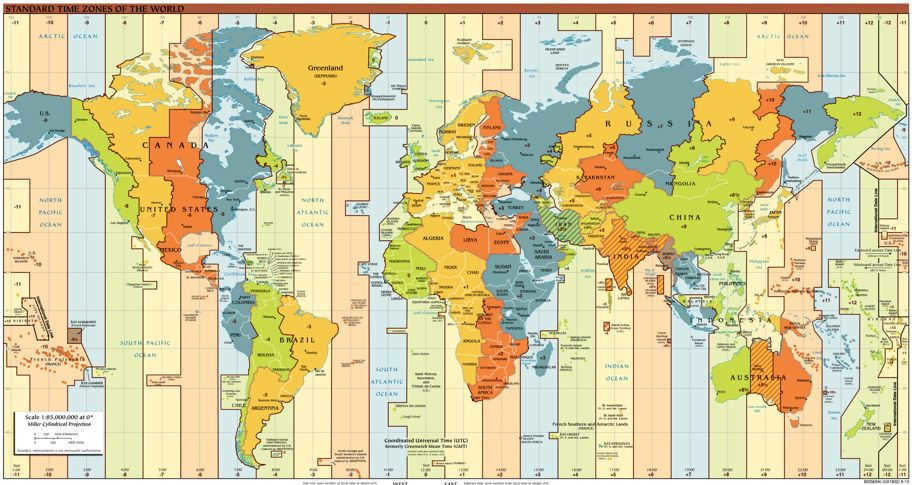
The accurate measurement of time plays a vital role in today’s fast-paced world. However, the challenge lies in dealing with various time zones. When interacting with individuals from different parts of the globe, it is crucial to establish a common time frame. This is where Coordinated Universal Time (UTC) comes into play. But how did this system come about?
Prior to the implementation of time zones, each locality relied on its own local solar time. This was determined based on the geographical longitude of the particular area or the nearest major city. As a result, even neighboring countries experienced significant time differences. As people began to travel more frequently, this gave rise to numerous complications.
Seafarers were the first to experience the inconvenience. However, due to their extended time at sea and infrequent visits to ports, they were able to easily adapt to local timekeeping. Still, during the Middle Ages, countries such as Portugal, Spain, France, England, and Italy made efforts to establish a standard “zero meridian” as a point of reference. It should be noted that Greenwich was not yet considered during this period, with each nation using its own reference point.
It was not until the railroad network began to develop that the issue became more pressing. The movement of trains became confusing because each settlement operated on its own time. For instance, a traveler going from Maine to San Francisco in the United States had to adjust their clock approximately 20 times! This time discrepancy not only inconvenienced passengers, but also led to accidents.
Thus, the issue of determining a universal reference meridian was brought up in 1870. The following year, the inaugural International Geographical Congress took place in Antwerp. However, the discussions centered solely on maritime charts, specifically advocating for the adoption of the Greenwich meridian as the zero meridian for such charts. No mention was made regarding maps of the mainland. Consequently, individual nations were still free to adhere to their respective prime meridians.
What exactly is Coordinated Universal Time (UTC)?
However, how did such a system come about?
The Origins of a Universal Standard
In the beginning, humanity relied on the Sun to determine time. The highest point of the Sun’s path across the sky was designated as noon. This basic principle served as the foundation for sundials. However, this method lacked accuracy and as society progressed, a more universal standard became necessary. As new lands were discovered and people recognized the need for time zones to facilitate navigation, the GSM (Greenwich Mean Time) system was created. The name was derived from the fact that the meridian used as the reference for timekeeping passed through the observatory located in Greenwich.
Incidentally, prior to the implementation of this standard, various nations relied on their own zero points. Typically, the central meridians in these cases were aligned with local observatories, such as Paris in France, etc. However, the absence of a unified standard proved to be inconvenient. Consequently, in 1884, the Greenwich meridian was established as the zero meridian. This meridian not only serves as a reference for timekeeping, but also enables the determination of geographic coordinates – longitude.
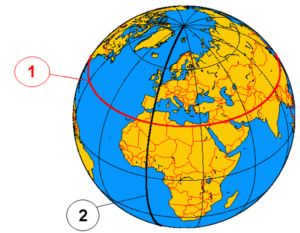
Coordinated Universal Time is the current name for the standard previously known as Greenwich Mean Time (GMT). Unlike GMT, UTC is measured using atomic clocks and is periodically adjusted by adding an additional second every 2-3 years. This adjustment is made to ensure that UTC aligns as closely as possible with astronomical time.
Designation of Time Zones
The time in different meridians is measured relative to Greenwich time. To simplify matters, it is expressed as the difference from Greenwich time, such as UTC+1, UTC-8, and so on. However, meridians are not always used to define time zones, as this can be inconvenient in certain cases. Interestingly, this inconvenience has led to some fascinating peculiarities in timekeeping across various countries.
So, once it became apparent what coordinated time entails, it is worth delving into its utilization in today’s society. Firstly, the prime meridian continues to hold significance in navigation – both at sea and in the skies.
The prime meridian – serves as a geographic meridian utilized as the point of origin for geographic longitude. Consequently, the longitude of this meridian, in the established reference system, is zero degrees.
The selection of the zero meridian holds no physical significance, unlike the equator, for instance, and is determined by the geographer’s discretion. Throughout certain periods in history, multiple prime meridians have been employed. An international consensus on a singular prime meridian was reached in 1884.
There were objections raised, but delegates primarily argued that over 70% of the total cargo capacity of commercial ships already using the Greenwich meridian. As a result, it was decided at the conference to implement time zones.
Furthermore, globalization has had its own impact on the necessity of a universal time reference. Conference calls between individuals located on opposite sides of the globe are coordinated based on UTC.
Interestingly, certain regions do not technically have time zones. This is particularly true for the Arctic and Antarctic, where time is generally considered to be UTC+0. In reality, researchers at polar stations have the freedom to keep track of time as they see fit. The same applies to astronauts working in Earth’s orbit.
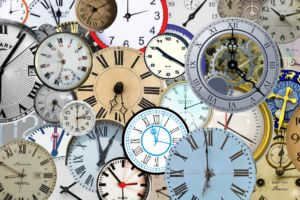
UTC
Interesting facts
Coordinated Universal Time (UTC) is a system that has evolved over time, resulting in some fascinating features.
- The abbreviation UTC does not officially stand for anything. When the standard was introduced in 1970, options such as TUC (Temps Universel Coordonné) and CUT (Coordinated Universal Time) were considered. Ultimately, it was decided to use the neutral acronym UTC.
- From a logical standpoint, the maximum time difference between two points on the planet should be 24 hours. However, in reality, there exist 26 time zones. In the Pacific Ocean, there are two island nations in relatively close proximity to each other: American Samoa and the Line Archipelago. The time difference between them amounts to 25 hours. This anomaly arose due to the fact that the Line Islands, which were previously under British ownership, aligned their time with that of Australia, resulting in a UTC+14 offset. On the other hand, Samoa follows a UTC-11 offset, in accordance with its deviation from continental America.
- In certain regions of Australia, horizontal time zones are occasionally observed. This phenomenon can be attributed to the fact that not all states observe daylight saving time.





